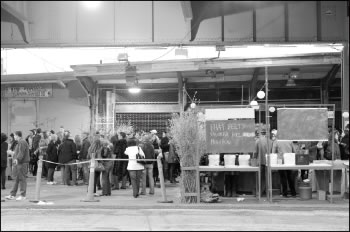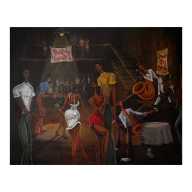BY Terese Loeb Kreuzer
The weather cooperated — predicted rain did not materialize. It was neither too hot nor too cold on April 9 as around 900 people crowded into a parking lot on South Street between Beekman and Fulton Streets for what was billed as an Oyster Saloon to benefit the New Amsterdam Market.
They sampled delicacies such as pan-roasted oysters from renowned chef April Bloomfield of The John Dory Bar, oysters Rockefeller from Great Performances, grilled oysters from Luke’s Lobster, wild oysters from the deep waters of Long Island Sound, and farmed oysters from up and down the East Coast. They drank draught beer and freshly brewed coffee and snacked on moist, spicy gingerbread for dessert. The event raised around $30,000 for the New Amsterdam Market, a farmers’ market selling regional produce and products that is scheduled to open for the season on May 1 with Sunday markets weekly in front of the closed stalls of the old Fulton Fish Market.
Robert La Valva, founder of the New Amsterdam Market, was happy with the response to the Oyster Saloon. He said that it showed that people knew about the New Amsterdam Market and were eager to support it. He would like to make it a permanent fixture in and around the historic Fulton Fish Market buildings, where, he said, there have been markets for centuries.
But the Howard Hughes Corp., which has a long-term lease on the South Street Seaport from Piers 16 and 17 to Water Street and from John Street to Beekman may have other ideas.
When General Growth, the previous leaseholder of the area, filed bankruptcy in 2008, it spun off 34 assets that were not central to its operations. Shareholders of General Growth became shareholders of the Howard Hughes Corp., which was created on Nov. 9, 2010 as an independent, publicly traded real estate company with assets spanning 18 states from New York to Hawaii. One of those assets was the South Street Seaport.
According to Howard Hughes Corp.’s Chief Executive Officer David R. Weinreb in a letter to shareholders dated April 7, 2011, Ward Centers, a 60-acre property in Honolulu, Hawaii, and the South Street Seaport “represent substantial redevelopment opportunities.”
Weinreb notes that “South Street Seaport is one of the top five most visited sites in New York City.” He goes on to say that, “When the U.S. economy recovers, those assets that are best located will be primed for development.”
William A. Ackman, chairman of Howard Hughes Corp., said that at $3.1 million — the book value of the South Street Seaport — the property is undervalued. “Last year, it generated more than $5 million in cash net operating income,” he said in a letter to shareholders, “and this number meaningfully understates the future cash-generating potential of this property as G.G.P. [General Growth Properties] generally discontinued granting long-term leases to tenants as it prepared the property for a major redevelopment. Even using the $5 million N.O.I. number, one can get to values approaching $100 million using cap rates appropriate for New York City retail assets, and we would likely leave a lot of money on the table if we sold it for this price.”
He said that if the South Street Seaport were sold, the sale could generate “large amounts of income” because the book value is so much less than market value, but such a sale “might be destroying long-term shareholder value…particularly if we believe materially more value can be created through redeveloping and releasing these assets over time.”
Grant Herlitz, president of Howard Hughes Corp. said that the company is “assessing and reassessing” what should become of the South Street Seaport. “We’re not yet a point where we’re ready to make a recommendation,” he said. “We’re working closely with the City to come to a resolution that will reenergize the South Street Seaport and once we do that, everybody will be pleased.”
The plan that General Growth Properties had floated, which included putting up a 495-foot-tall hotel and apartment building, demolishing the mall on Pier 17, moving the Tin Building to that site and erecting a low-rise, boutique hotel is still on the table.
“That’s one of the options,” said Herlitz, “but it’s not the only option.”
He said that he was aware that many in the Lower Manhattan community had opposed the G.G.P. plan. “Once we come up with the options that we think are most viable, we will absolutely try to get as much community support as we can get,” he said. “After all, the Seaport has to serve the community so it wouldn’t do us any good to try to serve a community that is opposed.”
He said that Howard Hughes Corp. hopes to release a plan for the Seaport later in 2011. Meanwhile, Robert La Valva is rounding up 40 to 50 vendors for each of his weekly markets. “It’s important just to keep the market going because it’s its own best spokesperson as the market,” La Valva said, “and the more we do it….” He did not complete the sentence. But he said the market will definitely open on May 1, “and we’ll be putting up a Maypole!”


































